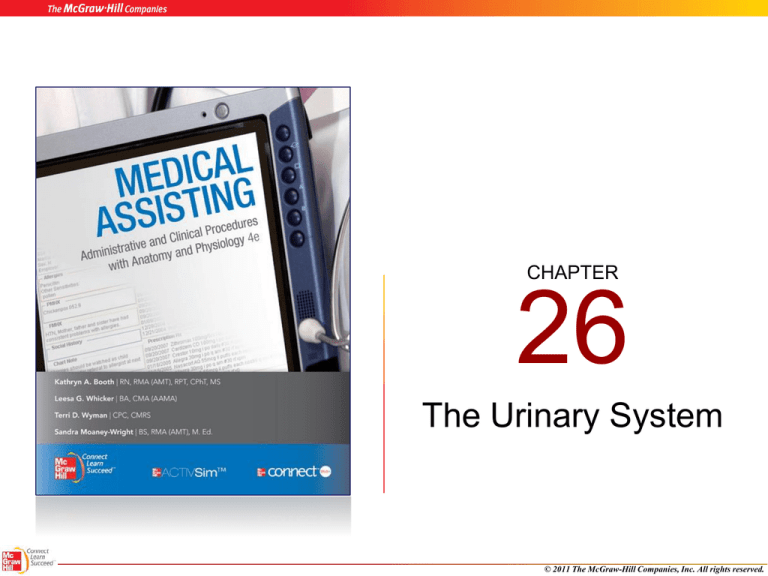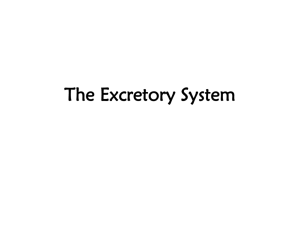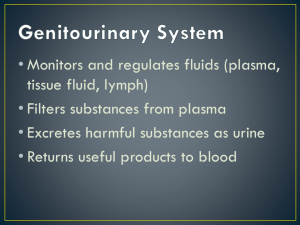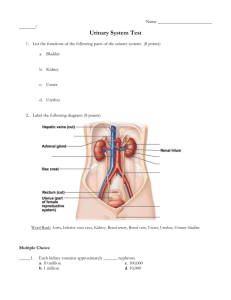
CHAPTER
26
The Urinary System
© 2011 The McGraw-Hill Companies, Inc. All rights reserved.
26-2
Learning Outcomes
26.1 Describe the structure, location, and
functions of the kidney.
26.2 Define the term nephron and describe its
structure.
26.3 Explain how nephrons filter blood and form
urine.
26.4 List substances normally found in urine.
© 2011 The McGraw-Hill Companies, Inc. All rights reserved.
26-3
Learning Outcomes (cont.)
26.5 Describe the locations, structures, and
functions of the ureters, bladder, and urethra.
26.6 Explain how urination is controlled.
26.7 Describe the causes, signs and symptoms,
and treatments of various diseases and
disorders of the urinary system.
© 2011 The McGraw-Hill Companies, Inc. All rights reserved.
26-4
Introduction
Kidneys
Ureters
Bladder
Urethra
• System functions to remove waste products from the
blood
• Main functional units of the kidneys are the nephrons
• Nephrons filter the blood and form the urine
© 2011 The McGraw-Hill Companies, Inc. All rights reserved.
26-5
The Kidneys
Functions
Remove metabolic waste products from the blood
Secrete the hormone erythropoietin, which stimulates
bone marrow to produce red blood cells
Secrete the hormone renin, which helps regulate blood
pressure
Description
The kidneys are bean-shaped organs that lie behind the
peritoneal cavity (retroperitoneal) on either side of the
vertebral column.
© 2011 The McGraw-Hill Companies, Inc. All rights reserved.
26-6
The Kidneys (cont.)
• Renal sinus – concave depression of the
surface of the kidney
• Hilum – point of entry for the renal artery,
renal vein, and ureter
• Renal pelvis – expansion of the ureter
that further divides into calyces
Kidney
© 2011 The McGraw-Hill Companies, Inc. All rights reserved.
26-7
The Kidneys (cont.)
• Renal cortex – outermost portion of the
kidney that covers the pyramids and dips
down between them
• Renal medulla – middle portion that also
divides into renal pyramids
• Renal column – portion of the cortex
between pyramids
Kidney
© 2011 The McGraw-Hill Companies, Inc. All rights reserved.
26-9
Nephrons
• Removes waste products from the blood
• Each kidney contains about 1 million nephrons
• Made of a renal corpuscle and a renal tubule
Extend from the Bowman’s
capsule of a nephron
Consist of three parts:
Proximal convoluted tubule
Loop of Henle
Distal convoluted tubule
Renal
Tubules
Composed of a group of capillaries
called a glomerulus
Glomerulus is surrounded by
Glomerulus
Bowman’s capsule
Blood filtration occurs in corpuscle
Renal
Corpuscles
© 2011 The McGraw-Hill Companies, Inc. All rights reserved.
26-11
Nephrons (cont.)
Afferent Arteriole
Glomerulus
Afferent arterioles deliver
blood to the glomeruli
Efferent arterioles carry
blood from the glomeruli to
peritubular capillaries
Efferent Arteriole
Peritubular Capillaries
Veins of the Kidney
© 2011 The McGraw-Hill Companies, Inc. All rights reserved.
26-12
Apply Your Knowledge
What are the functions of the kidney?
ANSWER: The kidney removes metabolic waste
products from the blood, secretes erythropoietin to help
regulate RBC production, and secretes renin to help
regulate the BP.
Correct!
© 2011 The McGraw-Hill Companies, Inc. All rights reserved.
26-13
Urine Formation
• Glomerular Filtration
– First process occurs in
renal corpuscles
– Fluid part of the blood
is forced from
glomerulus into
Bowman’s capsule
• Becomes glomerular
filtrate
Glomerulus
© 2011 The McGraw-Hill Companies, Inc. All rights reserved.
26-14
Urine Formation (cont.)
• Factors affecting glomerular
filtration
– Filtration pressure – amount of
pressure that forces filtrate from
the glomerulus into Bowman’s
capsule
• Determined by blood pressure
– Rate of filtration – sympathetic
nervous system control
• Constriction of afferent arterioles
decreases filtration pressure
© 2011 The McGraw-Hill Companies, Inc. All rights reserved.
26-15
Tubular Reabsorption
• Second process in urine formation
• Glomerular filtrate proximal convoluted tubule
– Nutrients, water, and ions pass through the walls of
the renal tubule into the peritubular capillaries
• Water reabsorption depends on hormones
– Antidiuretic hormone (ADH)
– Aldosterone
– Both increase water reabsorption, which decreases
urine production
Tubular
Reabsorption
© 2011 The McGraw-Hill Companies, Inc. All rights reserved.
26-16
Tubular Secretion
• Third process of
urine formation
• Substances move
from blood in the
peritubular
capillaries into the
renal tubules
• Secreted substances
– Drugs
– Hydrogen ions
– Waste products
Tubular
Secretion
© 2011 The McGraw-Hill Companies, Inc. All rights reserved.
26-18
Urine Formation (cont.)
• Urine composition
– Mostly water
– Urea and uric acid
• Formed by the breakdown of proteins and nucleic
acids
– Trace amounts of amino acids and various
ions
• Secretion of waste products helps
maintain the acid-base balance
© 2011 The McGraw-Hill Companies, Inc. All rights reserved.
26-19
Apply Your Knowledge
Match the following:
ANSWER:
___
B Second process in urine formation
A. Glomerular filtration
___
C Substances move from blood into renal tubules
B. Tubular reabsorption
___
A Depends on filtration pressure
C. Tubular secretion
___
C Third process of urine formation
___
A First process of urine formation
___
B Filtrate flows into the proximal convoluted tubule
Nice
Job!
© 2011 The McGraw-Hill Companies, Inc. All rights reserved.
26-21
Urinary Bladder
• Expandable muscular organ
– Stores up to 600 ml urine on average
• Detrusor muscle – smooth muscle in wall of
bladder
• Trigone – triangle on internal floor of bladder
formed by urethra and ureters
• Micturation
– Process of urination
– Stretching of bladder triggers process
• Approximately 150cc of urine
Bladder
© 2011 The McGraw-Hill Companies, Inc. All rights reserved.
26-22
Previous
© 2011 The McGraw-Hill Companies, Inc. All rights reserved.
26-23
Urination
Brain stem
and
cerebral
cortex
Impulses to contract
urethra; inhibit
Spinal cord
micturition impulse
until ready to
urinate
Parasympathetic
nerves stimulate
detrusor muscle
Stretch
receptors
Bladder
distends
– External urethral
sphincter relaxes
– Micturition reflex –
impulses from pons
and hypothalamus
– Detrusor muscle
contracts
– Urine expelled
© 2011 The McGraw-Hill Companies, Inc. All rights reserved.
26-24
Urethra
• Tube that moves urine from the bladder to
the outside world
• Shorter in females – patient education
– Urinate when urge occurs
– Drink adequate clear fluids
– Wipe front to back
– Urinate after intercourse
Urethra
© 2011 The McGraw-Hill Companies, Inc. All rights reserved.
26-25
Apply Your Knowledge
True or False:
ANSWER:
___
T Ureters move urine by peristalsis.
trigone
F The detrusor is formed by the openings of the ureters and urethra.
___
T The process of micturition is triggered when the bladder contains
___
about 150 ml urine.
ureters
___
F The urethra move urine from the kidney to the bladder.
___
F The urethra is longer in females. males
T Contraction of the detrusor muscle pushes urine from the bladder.
___
© 2011 The McGraw-Hill Companies, Inc. All rights reserved.
26-26
Diseases and Disorders of the Urinary System
Disease/Disorder
Description
Acute renal failure
Sudden loss of kidney function; may
be reversible with treatment
Chronic renal failure
Kidneys slowly lose ability to function;
not reversible
Urinary bladder infection; more
common in females
Cystitis
Glomerulonephritis Inflammation of the glomeruli of the
kidney; one cause of chronic renal
failure
Incontinence
Inability to control urination
© 2011 The McGraw-Hill Companies, Inc. All rights reserved.
26-27
Diseases and Disorders of the Urinary System
Disease/Disorder Description
Polycystic kidney
disease
Pyelonephritis
Renal calculi
Enlargement of kidneys because of the
presence of many cysts within them;
slow, progressive disease
Complicated urinary tract infection; starts
with a bladder infection and spreads to
both kidneys; can be acute or chronic
Kidney stones; can become lodged in
ducts within kidneys or ureters
© 2011 The McGraw-Hill Companies, Inc. All rights reserved.
26-28
Apply Your Knowledge
Matching:
ANSWER:
G
O
B. Glomerulonephritis
O
C. Incontinence
D
D. Chronic renal failure
J
E. Renal calculi
O
F. Cystitis
B
G. Acute renal failure
H. Polycystic kidney disease !
A Complicated urinary tract infection A. Pyelonephritis
___
___
C Inability to control urination
E Kidney stones
___
D Slow loss of kidney function
___
___
F Bladder infection
B Inflammation of the glomeruli
___
H Kidney enlargement due to cysts
___
G Sudden loss of kidney function
___
© 2011 The McGraw-Hill Companies, Inc. All rights reserved.
26-29
In Summary
26.1 The retroperitoneal kidneys are composed of the
outer renal cortex and inner renal medulla. Their
function is to remove metabolic waste from the body.
26.2 A nephron is a single kidney cell. It is composed of a
renal corpuscle containing the glomerulus and
Bowman’s capsule and the three sections of the renal
tubule: proximal convoluted tubule, loop of Henle, and
distal convoluted tubule.
© 2011 The McGraw-Hill Companies, Inc. All rights reserved.
26-30
In Summary (cont.)
26.3 The nephrons filter blood and form urine through
three processes: glomerular filtration, tubular
reabsorption, and tubular secretion.
26.4 Some of the components of urine include water, urea,
uric acid, trace amounts of amino acids, and various
ions.
26.5 The two ureters are long tubes extending from each
renal pelvis that bring urine to the bladder for storage.
The urethra is the muscular tube extending from the
bladder that allows urine to be expelled from the
body.
© 2011 The McGraw-Hill Companies, Inc. All rights reserved.
26-31
In Summary (cont.)
26.6 Urination is controlled by a variety of factors including
bladder distention, parasympathetic nerve stimulation,
brain impulses affecting urethral sphincters, and
contractions of the detrusor muscles of the bladder.
26.7 The diseases and disorders of the urinary system
include infections of the bladder and kidneys, bladder
control, and the different types of renal (kidney) failure
and disease. These are discussed in more detail in
the Pathophysiology section of this chapter.
© 2011 The McGraw-Hill Companies, Inc. All rights reserved.
26-32
End of Chapter 26
This too shall pass—
just like a kidney stone.
~H. Madson
© 2011 The McGraw-Hill Companies, Inc. All rights reserved.








